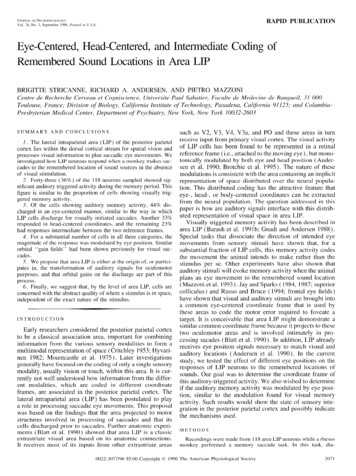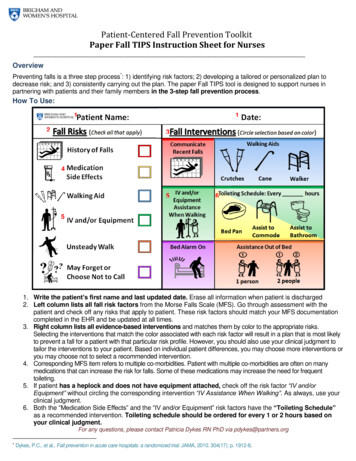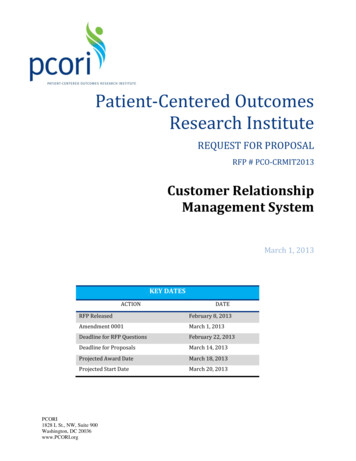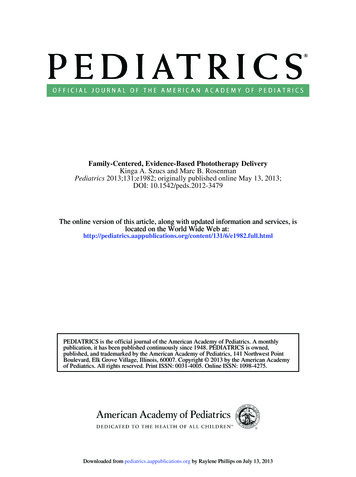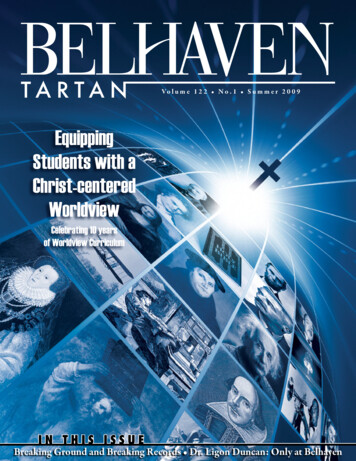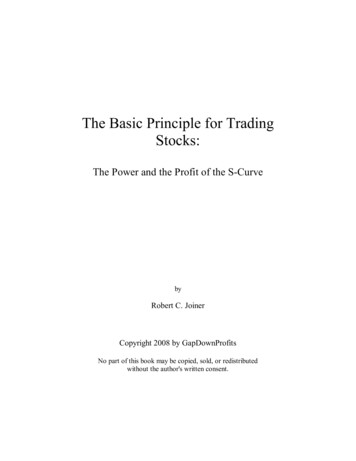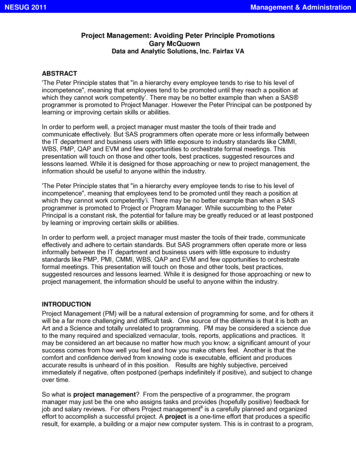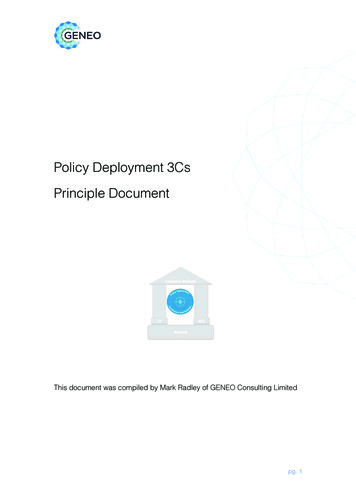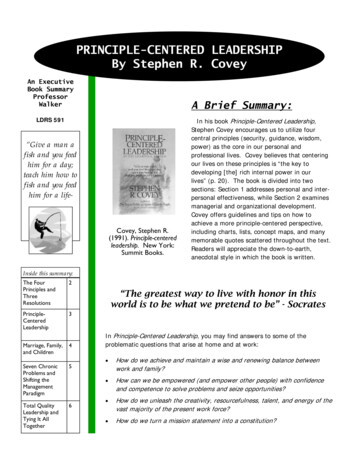
Transcription
PRINCIPLE-CENTERED LEADERSHIPBy Stephen R. CoveyAn ExecutiveBook SummaryProfessorWalkerA Brief Summary:LDRS 591“Give a man afish and you feedhim for a day;teach him how tofish and you feedhim for a life-Covey, Stephen R.(1991). Principle-centeredleadership. New York:Summit Books.In his book Principle-Centered Leadership,Stephen Covey encourages us to utilize fourcentral principles (security, guidance, wisdom,power) as the core in our personal andprofessional lives. Covey believes that centeringour lives on these principles is “the key todeveloping [the] rich internal power in ourlives” (p. 20). The book is divided into twosections: Section 1 addresses personal and interpersonal effectiveness, while Section 2 examinesmanagerial and organizational development.Covey offers guidelines and tips on how toachieve a more principle-centered perspective,including charts, lists, concept maps, and manymemorable quotes scattered throughout the text.Readers will appreciate the down-to-earth,anecdotal style in which the book is written.Inside this summary:The FourPrinciples �The greatest way to live with honor in thisworld is to be what we pretend to be” - SocratesMarriage, Family,and Children4Seven ChronicProblems andShifting theManagementParadigm5Total QualityLeadership andTying It AllTogether6In Principle-Centered Leadership, you may find answers to some of theproblematic questions that arise at home and at work: How do we achieve and maintain a wise and renewing balance betweenwork and family? How can we be empowered (and empower other people) with confidenceand competence to solve problems and seize opportunities? How do we unleash the creativity, resourcefulness, talent, and energy of thevast majority of the present work force? How do we turn a mission statement into a constitution?
The Four PrinciplesThere are no “quick fixes” or short-term approaches to solving problems. As “TheLaw of the Harvest” teaches us, you cannot forget to plant and goof off during thespring and summer, and still expect to reap a bountiful harvest in the fall. It justdoesn’t work. We need to understand that there are natural laws or governing principles that underlie our behaviour and our very existence as human beings.Hence, the four principles:Security(our sense of worth, identity,emotions, self-esteem, andpersonal strength)The author,Stephen R.Covey.Wisdom(a sense of balance,judgement, rue north’direction toour lives whenGuidance(the direction wereceive in life)Power(the capacity to act, thestrength and courage toaccomplish something)These principles are like compasses; they point us in the right way and show us thedirection we need in our everyday lives. Principles are constant; they apply at alltimes and in all places. “Principle-centered leadership is based on the reality that wecannot violate these natural laws” (p. 19). By placing these four principles at thecenter of our lives, at our core, we can be sure it unifies and integrates the other aspects of our lives (see figures below):navigatingthe ‘streams’of ourenvironments”(p. 19).Personal LifeProfessional LifeThree Resolutions“The key to growth is tolearn to make promisesand to keep them” (p. 55).1. Exercise self-discipline and self-denial.2. Work on character and competence.3. Dedicate your talents and resources to noble purposes and to provide service toothers.An Executive Book SummaryProfessor WalkerPage 2
Principle-Centered LeadershipCovey emphasizes that principle-centered leadership is practiced from the inside-out.Personal and organizational transformation must come from within. We cannotcontrol what others do, but we can certainly control our own decisions andbehaviours. In order to achieve personal and organizational effectiveness, one mustalso be committed and able to think with a long-term perspective. Covey encouragesprinciple-centered leaders to build greater, more trusting and communicative relationships with others in the workplace and in the home.So what does a principle-centered leader look like? In Chapter 1, Covey identifieseight defining characteristics of people who are principle-centered leaders:Eight Characteristics of Principle-Centered Leaders1.2.3.4.5.6.7.8.They are continually learning.They are service-oriented.They radiate positive energy.They believe in other people.They lead balanced lives.They see life as an adventure.They are synergistic.They exercise for self-renewal.Four levels in which to practice the Four Principles“Trust—or thelack of it—-is atthe root ofsuccess orfailure inrelationships andin thebottomline results ofbusiness,industry,education, andgovernment”(p. 31).As stated above, principle-centered leadership is practiced from the inside out and onfour levels. We need to utilize the four principles (security, guidance, wisdom, power)along these four levels (personal, interpersonal, managerial, and organizational).Organizational—my need to organizepeopleManagerial—my responsibility to get ajob done with othersInterpersonal—my relationships and interactions with othersPersonal—my relationship with myselfAn Executive Book SummaryProfessor Walker“If you want thesecondary greatnessof public recognition,focus first onprimary greatnessof character” (p. 63).Page 3
Marriage, Family, and ChildrenAs we can all relate and perhaps even attest to, our professional lives are ofteninfluenced by our personal lives. Disharmony and disorder in the home and familydomain can have an adverse effect on professional successes. We need to ensurethat marriage and family relationships are healthy for they play a large role in ourdaily work lives. Throughout Covey’s book, the ideals of principle-centered leadershipare central to how we should conduct and carry ourselves in the home and with ourfamilies. Covey believes so strongly in the values of marriage, family, and childrenthat he devotes two chapters to the development of marital and familial relationships.The key points from each of these chapters are highlighted below:Eight ways to enrich marriage and family relationships1. Retain a long-term perspective.Three charactertraits are essentialto primarygreatness:2. Rescript your marriage and family life.3. Reconsider your roles.4. Reset your goals. Integrity5. Realign family systems. Maturity6. Refine three vital skills (time management,communication, and problem-solving). AbundanceMentality7. Regain internal security.(there is plentyout there foreverybody)8. Develop a family mission statement.Making Champions of Your Children1. Build your children’s self-esteem.2. Encourage primary greatness.3. Encourage your children to develop their own interests.4. Try to create an enjoyable family culture.5. Plan ahead for family events.6. Try to set an example of excellence.7. Teach them to visualize so that they can recognize their own potential.8. Adopt their friends.9. Teach your children to have faith, to believe and trust others, and toaffirm, build, bless, and seve others.An Executive Book SummaryProfessor WalkerPage 4
Seven Chronic ProblemsAcute and chronic are words that are often used in the medical field. Acute pain ispain that flares up quickly. It causes us immediate distress and discomfort. On theother hand, chronic pain is more long-term and constant. It is unrelenting andlingering. Moreover, chronic pain may be difficult to diagnose and/or cure.In organizations, there can be chronic problems, problems that are long-lasting,persistent, and painful. Chronic organizational problems require much more than“quick-fix” solutions. Solving chronic problems often require time, direction, andcommitment from all individuals in the organization. In Principle-CenteredLeadership, Covey identified seven chronic problems that can be found universallyin organizations:The organization has:Individuals within theorganization may bepart of the chronicproblems; however,these same individualscan also be part of thesolutions.1. No shared vision or values.2. No strategic path.3. Poor alignment.“I’m confident that4. Wrong style.enlightened leaders5. Poor skills.can cure these seven6. Low trust.chronic problems,7. No self-integrity.but to do thatthey’ve got toShifting the Management Paradigmchange hearts, buildSo the question is “How do we become more effective?” Covey reveals that in orderto make “quantum improvements,” it is necessary to change your way of thinking, tochange your paradigm.trust, revise thestructure and“The great breakthroughs are breaks with old ways of thinking” (p. 173).In your own life, you may have experienced paradigm shifts. Think of the time youtaught a different grade or subject area. Or when you got married, and shifted fromthe single life to life with a spouse. During these times, your way of thinking likelychanged. How you viewed the world, how you viewed your responsibilities, or howyou viewed your role in life probably changed as well.Throughout the book, Covey has encouraged his readers to change the paradigmwith which they view leadership. He acknowledges that there are different leadershipparadigms out there (i.e., scientific authoritarian, benevolent authoritarian, humanresource), but he believes principle-centered leadership is the leadershipparadigm that is most holistic. Principle-centered leadership “embraces the principlesof fairness and kindness and makes better use of the talents of people for increasedefficiency, but also leads to quantum leaps in personal and organizationaleffectiveness” (p. 180).An Executive Book SummaryProfessor WalkerPage 5“enlightenment”
Total Quality andPrinciple-Centered LeadershipTotal quality is the continuous improvement in the four levels described earlier in thesummary: personal and professional development, interpersonal relations, managerialeffectiveness, and organizational productivity. Total quality values people. It isrooted in the timeless principles of faith and hope, constancy and consistency, andvirtue and truth in human relations.Principle-centeredleadership provides thefoundation for TotalQualityTotal quality can be achieved through Principle-Centered Leadership (PCL). PCLprovides the two elements essential to the quality process: leadership and people.PCL empowers people and organizations so that they can achieve their potential andbecome more effective in whatever they do.“Principle-Centered Leadership enables organizationsto achieve their Total Quality objectives” (p. 263).About the Author:Stephen Covey is a world-renownedauthor and expert in the field ofleadership. He is probably best knownfor his popular book The 7 Habits ofHighly Effective People.Covey is also a co-founder andco-chairman of the Covey LeadershipCentre, the largest management andleadership centre in the world.Tying it all togetherAn Executive Book SummaryPrinciple-Centered Leadership is a significant read for allmembers of an organization, not just leaders. It focuses onindividuals and their roles in family life and the work place.After critically reading and analyzing the numerous points inCovey’s book, his central message seems to be build yourcharacter from within. Focus on building trust and effectivecommunication with others; this in turn, will enable you to guideyourself and others at home and at work with a principlecentered approach.In our own professional lives as educators, we often deal withmany outside influences. Covey suggests shifting the traditionalstudent-teacher relationship to a model in which we create aPrinciple-Centered Learning Environment. In such an environment, the student is empowered. All stakeholders are identifiedand share equal responsibility in providing the best learningenvironment for the student. At first, this may seem to be achallenging task, but all itrequires is a principle-centeredparadigm.and after readingthis summary, you now knowa little more about how toadopt a principle-centeredparadigm in your own life.Professor WalkerPage 6
Stephen Covey is a world-renowned author and expert in the field of leadership. He is probably best known for his popular book The 7 Habits of Highly Effective People. Covey is also a co-founder and co-chairman of the Covey Leadership Centre, the largest management and leadership centre in the world. Tying it all together Total quality is the continuous improvement in the four levels described .
